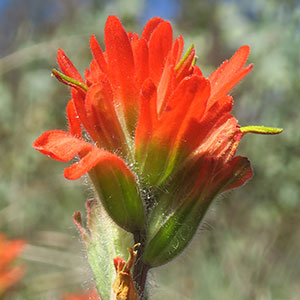Castilleja brevilobata
Castilleja sessiliflora
short-lobed paintbrush
downy paintedcup, Great Plains Indian paintbrush
solitary or few, erect or ascending, unbranched, sometimes branched, hairs spreading, short, medium, and long, soft, short and medium ones short stipitate-glandular.
few to many, ascending to erect, often decumbent at base, unbranched, sometimes branched, hairs spreading, sometimes matted, short to medium length, ± soft, eglandular, often with a layer of minute-glandular hairs, sometimes woolly.
green or ± yellow, lanceolate, elliptic, or oblong to narrowly ovate, 1–2(–2.5) cm, not fleshy, margins plane or wavy, involute, (0–)3–5(–7)-lobed, apex rounded to acute;
lobes ascending to erect, linear to lanceolate, apex rounded to acute.
green to purple, or grayish with dust and hairs, linear to narrowly lanceolate, (1–)2–5(–6) cm, not fleshy, margins plane, involute, (0–)3–5-lobed, apex acuminate to acute;
lobes divergent, spreading, linear, apex acute.
3–20 × 2–3.5 cm;
bracts proximally greenish to dull brown, distally red, orange-red, or scarlet, sometimes orange or yellow, broadly lanceolate or oblong, (0–)3–5-lobed;
lobes ascending, broadly to narrowly lanceolate, short, arising above mid length, apex acute, obtuse, or rounded.
3–18 × 2.5–6.5 cm;
bracts green to purplish throughout, sometimes reddish brown, pink, or lavender throughout, or distally white or pale yellow, sometimes distally dull pink, pink, salmon, orangish, pale pink-orange, buff, or cream, lanceolate, similar to distal leaves, 3(–5)-lobed;
lobes spreading, linear-lanceolate, long, arising at or below mid length, apex acute to acuminate, sometimes obtuse.
straight, 15–24(–26) mm;
tube 12–16 mm;
beak exserted, abaxial lip equal to calyx;
beak adaxially green or ± yellow-green, 7–10 mm, puberulent, stipitate-glandular;
abaxial lip deep green, reduced, rounded, 1–2 mm, 10–25% as long as beak;
teeth incurved to erect, light green, 0.5–1 mm.
strongly curved distally, 35–55 mm;
tube 24–45 mm;
abaxial lip, beak, and distal portion of tube exserted;
beak adaxially green, yellow, pinkish, purplish, or whitish, 9–15 mm;
abaxial lip green, pale green, or purple, protruding, shelflike, 4–8 mm, 50–70% as long as beak;
teeth spreading, white, pale yellow, pink, or purple, 3–4 mm.
green or whitish with green veins, lobes colored as bract lobes or paler, 14–30 mm;
abaxial and adaxial clefts 5.5–8.5 mm, 30–40% of calyx length, deeper than laterals, lateral 1.5–4 mm, 20–25% of calyx length;
lobes oblong to narrowly triangular, apex obtuse to rounded.
colored as bracts, sometimes proximally white, 20–40 mm;
abaxial and adaxial clefts 12–20 mm, 40–60% of calyx length, deeper than laterals, lateral 5–15 mm, 10–25% of calyx length;
lobes linear, apex acute to acuminate.
= 24.
= 24.
Castilleja brevilobata
Castilleja sessiliflora
Castilleja brevilobata is endemic to dry serpentine openings in the Siskiyou Mountains of southwestern Oregon and adjacent California. Although sometimes treated as part of C. applegatei or C. hispida, its morphology does not suggest a close connection with either. This species occasionally hybridizes with C. pruinosa in Del Norte County, California.
(Discussion copyrighted by Flora of North America; reprinted with permission.)
Castilleja sessiliflora ranges across the Great Plains from southern Canada to northern Mexico, where it is apparently rare. In Texas and northern Mexico, its range overlaps with the similar C. mexicana. Most populations of C. sessiliflora, especially north of Texas, have white to pale yellow inflorescences; in southwestern Texas they are more variable in color, with pink-purple plants often predominating locally. Those plants with pink-purple inflorescences were named forma purpurina by F. W. Pennell. In the limestone deserts of southern New Mexico and southeastern Arizona, the inflorescences are often a pale pink-orange, but these are intermingled with more typical greenish white plants. Occasional hybrids between C. angustifolia var. dubia and C. sessiliflora are known from northeastern Wyoming.
(Discussion copyrighted by Flora of North America; reprinted with permission.)


